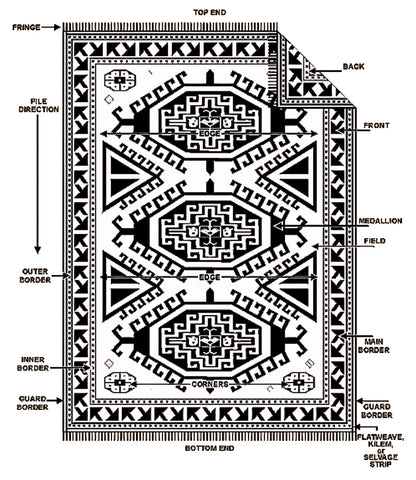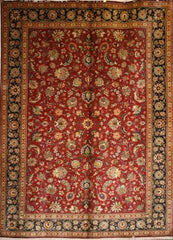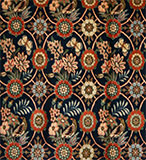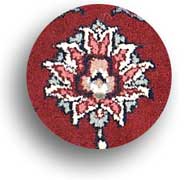Persian & Oriental Rug Design
RUG LAYOUTS AND DESIGNS
Rugs are generally woven to a pre-planned pattern, they have set characteristics and there are commonly found designs, these can be explained as:
Persian rugs, and rugs in general, have a limited number of layouts. Almost all of these have a number of elements in common, including the field, a border or multiple borders and some form of medallion or pattern.

Some of the most commonly used for Persian designs are the all-over, medallion and one-sided layouts. This simply refers to the type and location of the patterns used in the rug. Below is an example of the three layouts:
There are a number of patterns which are found in Persian and Oriental rugs called 'motifs', these designs have different meanings and tend to be used depending on the area the rug was woven although it is not unusual to find more than one motif in a single rug.
Some of the more common motifs are:
Boteh
Gul
Herati
Mina-Khani
Rosette
Shah Abbasi
Boteh is the Farsi word used to describe in immature flower or palm leaf. This motif is often found in a cluster (all-over pattern) however has been known to be used in isolation in intricate, artistic weaves.

Various interpretations of the design have included: Flames, Tear drops, Pine cones, Pears and Trees
In the 19th century in Scotland, the design which was then found on Kashmir shawls and scarfs was copied to make the now world famous Paisley shawls.
The Gul motif is often seen in Turkman, Gorgan and Khal Mohammadi rugs. 'Gul' is Farsi for flower and is normally used to describe these octagonal, all over or repeated patterns.
The Herati motif is a very common repeated field design which normally consists of a flower centred within a diamond surrounded by curved leaves parallel to each side of the diamond. This can be in various forms in either geometric or curvilinear designs.
Mina-Khani is used to describe this distinctive pattern used in many Persian rugs. The pattern is made up of repeated daisies interlinked by diamond (often curved) or circular lines. This design is used regularly in a number of different rug types and is not representative on one single area. The design is almost always an all-over patter, it can be found in many rugs but certain workshops almost exclusively use it such as those weaving Varamin rugs.
The Rosette design is a circular arrangement of motifs radiating out from the centre medallion suggesting the petals of a rose. This can be used in the borders however is mostly limited to the field and can be in either naturalistic or geometric form. The Rosette design is often found in Nain rugs.
This is the name given to a group of palmettes which can be found in all-over and medallion designs as well as in borders. Shah Abassi motifs are frequently seen in Kashan, Isfahan, Mashad and Nain rugs amongst others. But is perhaps most common in Tabriz rugs.



















